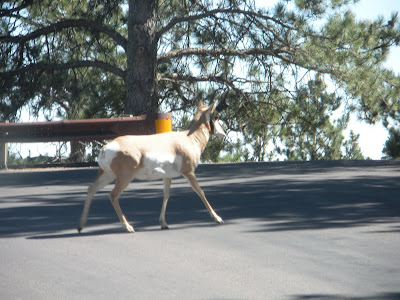
The Trek Across America 2010 was fantastic, but it's also great to be home. I've actually been back for several weeks. I was moving so fast at the end of the trip that I outran the blog and had to make the last several posts from home.
A few observations: I again enjoyed travelling across the country and seeing the varied landscapes and meeting people along the way. There's nothing quite like being in some incredible natural settings in your own mobile house. On the other hand, this trip moved a little too quickly. First of all, I had a deadline to meet in California at the Lazy Daze RV headquarters. This meant that I couldn't linger in any one place too long. I actually didn't spend more than one night in any one place until I had left California and was all the way up in Wyoming. I was moving several hundred miles each day - way too fast. And then, once I'd had the work done on the RV in California, I wanted to make sure I got back home before the birth of our first grandchild. (Mission accomplished there.)
Also, this was quite a hot summer. One reason I travelled across the north is that I thought it would be cooler there. Think again. It was hot pretty much everywhere I went except for up in the Rockies. In Michigan and Wisconsin (and most everywhere else) it was in the high 90s and very humid, and in southern California it was 107 on the day of my visit to the Lazy Daze factory. I skedaddled out of there as fast as I could. Thank goodness for generators and AC!
And finally, this was the last long trip I'll take alone. There are some great rewards to be had travelling by yourself, deep in your own thoughts, making on-the-spot decisions without compromise. But the downside is that it gets lonely. I'm fortunate to have a wonderful mate who loves to travel and who brings the additional bonus of getting actively excited about things. While I enjoy things more or less internally, I've many times over the years had the pleasure doubled (and tripled) by experiencing something through Tracey's eyes and heart. She's like having a set of "feelers" through which things are sensed with excitement, joy and jubilation.
I would have loved to hang around at many of the places I visited and that's exactly what Tracey and I will do next year when we hit the road. We'd like to do what many RVers do -- take at least one "rest" day in between travel days. Better yet, find a place that we'd like to explore and put down temporary roots for maybe a week or so.
But I do want to say that none of the "downsides" mentioned above negate the fact that I loved every minute of moving along the highways, seeing spectacular things, hiking wilderness trails, meeting interesting people, and feeling the "in the now" serenity that comes with getting away from familiar surroundings, routines, and obligations. And I was able to see a great many places that exemplify things that are uniquely American, which was one of my goals. Also, I've done a lot of "reconnaissance" for our future travels. I feel like I've paved the way for adventures yet to come.
Now here's a great reason to be back home ...

Sebastian Heng Blanton arrived at 5:21 p.m. on October 5, 2010. He was a very healthy 7 lbs., 13 oz. and measured 21 inches in length. His mom Malina and his dad Eric are ecstatic to be his parents. Grandma and Grandpa are pretty much over the moon.




















































